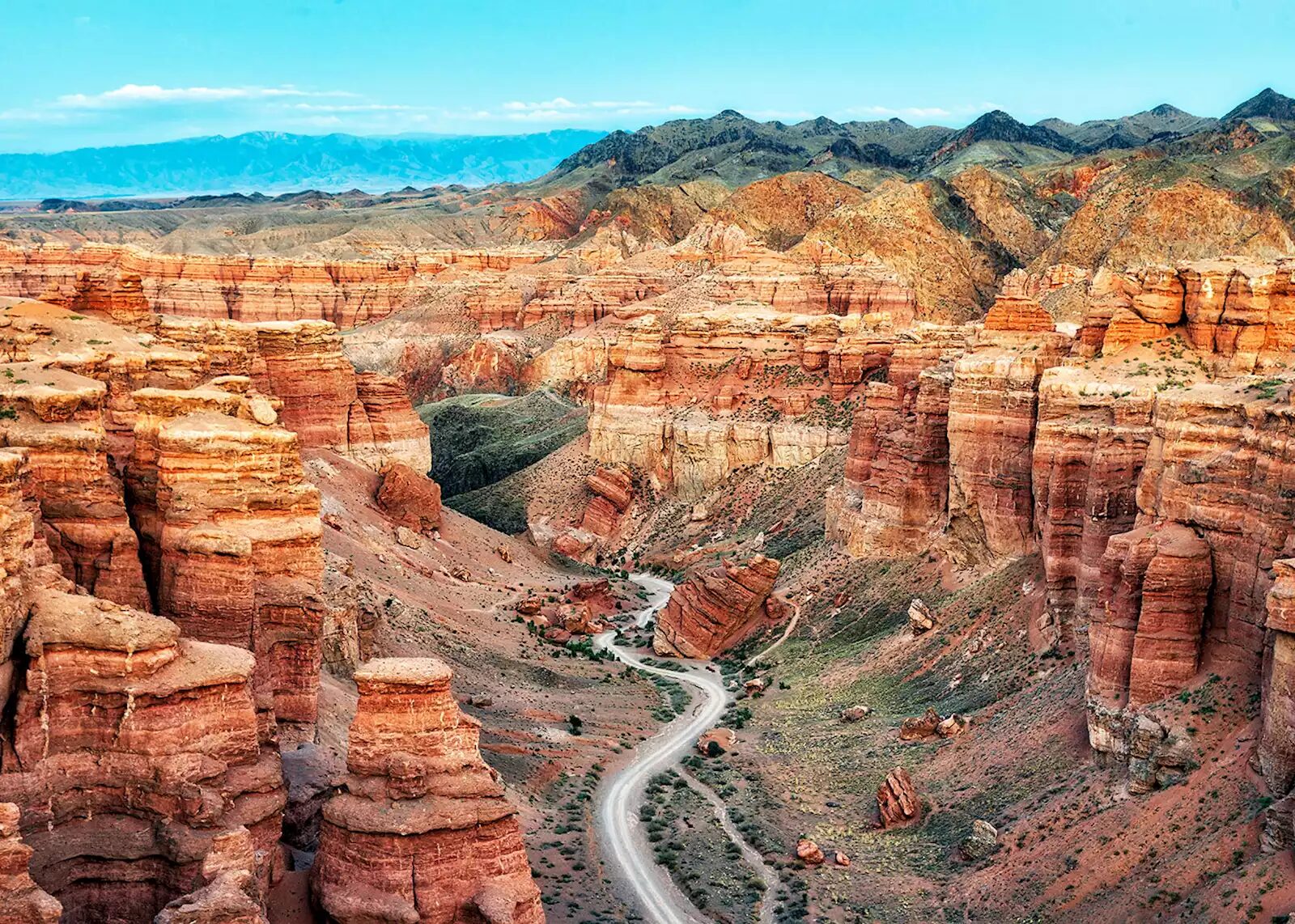Traveling through Central Asia offers one of the world’s most rewarding cultural experiences, where ancient Silk Road history comes alive through historic trading routes, traditional crafts, and authentic local cuisine. This comprehensive Uzbekistan and Kyrgyzstan travel guide takes you on a journey through the legendary Fergana Valley, past centuries-old ceramic workshops in Rishtan, across the pristine alpine lakes of Issyk-Kul, and into bustling bazaars that have served travelers since the time of Alexander the Great. From the turquoise-tiled palaces of Kokand to the mountain-ringed shores where caravans once rested, this Silk Road adventure reveals the region’s enduring legacy as a crossroads of civilizations where nomadic empires, powerful khanates, and diverse cultures created a rich tapestry of tradition that continues to captivate modern explorers seeking what to see on Silk Road journeys.
Understanding the Silk Road: History and Context
Before exploring specific destinations, understanding where is the Silk Road and its historical significance enriches the travel experience. The Silk Road wasn’t a single route but a network of trading routes connecting China, Central Asia, and the Middle East from approximately 200BC to AD1400. These ancient trading networks facilitated not just commerce in silk and spices, but also the exchange of ideas, religions, and technologies that shaped world history.
The region witnessed the rise and fall of ancient empires including those led by Alexander the Great, while nomadic traditions from horseback cultures influenced everything from warfare to cuisine. Understanding this Silk Road history and culture context makes each site more meaningful.
Rishtan: Where Ancient Ceramic Art Thrives
The Heart of Traditional Central Asian Crafts
Rishtan stands as one of Central Asia’s oldest ceramic art centers, where contemporary artisans maintain 800-year-old techniques dating back to the Silk Road era. Located in the Fergana Valley—a geographical region shared by Uzbekistan, Kyrgyzstan, and Tajikistan—this small city preserves traditional ceramic techniques that answer the question of how to travel the Silk Road while experiencing authentic craftsmanship.
During early autumn harvest season in Uzbekistan, meeting master ceramicist Alisher Nazirov provides insight into this ancient craft. Over fresh carved melons—a fruit famously beloved throughout the region—Nazirov explains that Uzbekistan has two primary pottery production centers: Rishtan in the Fergana Valley and Gijduvan, near the historic Silk Road city of Bukhara.
Discovering Silk Road Ceramic Art
Rishtan ceramics feature characteristic turquoise, dark blue, and brown designs on cream backgrounds, exemplifying traditional Central Asian crafts. This color palette reflects regional traditions and the specific mineral compositions of local clays and glazes used for centuries.
“Teapots and plates are decorated with pomegranate and flowers, and the legendary Huma bird, emblem of Uzbekistan,” Nazirov shared. “Every artist has their own style to draw this fantastical bird.” He noted that while many attempt this traditional craft, true master craftspeople are rare—perhaps only six among two-to-three hundred practitioners demonstrate complete mastery of this Central Asian art form.
Nazirov’s acclaimed ceramics are displayed at the Khan’s Palace in nearby Kokand, testament to his exceptional skill in this centuries-old tradition that represents one of the best Silk Road destinations for understanding regional artistry.
Kokand: Strategic Silk Road Crossroads
A Historic Trading Hub in the Fergana Valley
Kokand served as a vital Silk Road hub, its strategic location establishing it as a key trading center connecting merchants, scholars, and travelers moving between China, Central Asia, and the Middle East. This facilitated trade in silk, spices, and the region’s famous ceramics—goods that defined Silk Road commerce for centuries.
The journey from Rishtan to Kokand passes beneath beautiful canopies of grapes, arching over the landscape—a visual reminder of Uzbekistan’s agricultural abundance that has sustained communities since ancient times.
The Magnificent Khan’s Palace
As one of Uzbekistan’s oldest cities and a former Silk Road trading post, Kokand was once a powerful 19th-century khanate alongside Khiva and Bukhara. The Khan’s Palace reflects this historical prominence with its dazzling blue-tiled exterior—an iconic example of Central Asian Islamic architecture that features prominently in any Uzbekistan Kyrgyzstan itinerary.
The palace contains 113 rooms (though not all are accessible to visitors), each rich with murals, carpets, and painted ceilings. Pomegranate trees flourish in the courtyard, their fruit symbolizing prosperity in Central Asian culture and appearing frequently in ceramic decorations and textile patterns.
Traditional Central Asian Sweet: Kokand Halva
No visit to Kokand is complete without tasting Kokand halva, a fudge-like sweet dotted with nuts and dried fruit. Each piece represents edible art, continuing the city’s tradition of craftsmanship across multiple mediums. This traditional Central Asian sweet makes an ideal Silk Road snack for continued travels, answering practical questions about what to eat in Central Asia.
Osh: Where Silk Road Heritage Meets Soviet Legacy
Kyrgyzstan’s Ancient Trading City
Believed to be over 3,000 years old, Osh ranks as Kyrgyzstan’s oldest city. Legend attributes its founding to either King Solomon or Alexander the Great—two figures whose footsteps many travelers seek when exploring Alexander the Great’s footsteps through Central Asia. Located near the Uzbekistan border, Osh functioned as another significant Silk Road trading hub, though today the city displays unmistakable Soviet-era influence alongside its ancient heritage.
The Throne of Solomon: Central Asia’s Holiest Locations
The city’s most striking landmark is the Throne of Solomon (Sulaiman-Too), a jagged pile of grey rock rising 150 meters above the city. At the summit sits a prayer-room built in 1497 by teenaged Babur, founder of the Mughal dynasty, devoted diarist, and famously passionate melon lover who chronicled his appreciation for the region’s agricultural bounty.
This site holds immense religious significance as one of Central Asia’s holiest locations. Some believe the Prophet Muhammad prayed here, while others maintain that biblical Solomon ruled from this throne—making it essential for understanding Silk Road history and culture.
Experiencing Osh Bazaar
Osh city sprawls around the Ak-Buura River, which meanders through the ancient market district. The Osh bazaar experience centers on old rose-garlanded chaikhanas (traditional teahouses) that continue serving travelers just as they did during the Silk Road era.
In these teahouses, traders and travelers historically paused to refresh themselves with chai (tea), sharing tales of conflicts, exchanging political opinions, and spreading gossip. Tea culture in Central Asia is never rushed, with various spice route teas worth sampling as part of understanding what to eat in Central Asia.
Black tea infused with cumin or green tea rich with saffron both offer authentic tastes of the region, exemplifying how Persian, Chinese, Russian, and nomadic traditions blended along these routes. The leisurely pace of tea-drinking provides opportunities to absorb the market atmosphere and observe daily life continuing traditions centuries old, making the Osh bazaar experience one of the best Silk Road destinations for cultural immersion.
Issyk-Kul: Alpine Beauty Along the Silk Road
The World’s Second-Largest Alpine Lake
Leaving the Fergana Valley behind, the journey continues to Issyk-Kul, the world’s second-largest alpine lake after Lake Titicaca in Bolivia. This mountain-ringed body of water serves as Central Asia’s premier beach destination, where Kazakhs, Russians, and Kyrgyz people gather during warmer months. For travelers seeking Issyk-Kul travel information, the lake offers unique opportunities rarely found elsewhere in the region.
Historic Silk Road Rest Point
Issyk-Kul functioned as a strategic Silk Road rest point, providing fresh water amid the mountainous terrain of Kyrgyzstan. A branch of the Silk Roads once ran from the lake across the border to Kashgar in Xinjiang, China—homeland of the Muslim Uyghurs. Understanding this historical connection helps travelers appreciate how to navigate the best time to visit Silk Road destinations.
Experiencing Issyk-Kul’s Alpine Waters
The water, though strikingly beautiful, proves freezing and goosebump-inducing—belying local lore that claims this inland sea remains warm because it reaches down to Earth’s molten core. This experience of Issyk-Kul’s alpine waters provides memorable contrast to the desert landscapes elsewhere along Silk Road routes.
Fruit in Kyrgyzstan is exceptional, benefiting from diverse microclimates and agricultural traditions. Visitors from Siberia and other regions often marvel at tasting fresh peaches and other produce that surpasses anything available in their home regions. This agricultural bounty represents one element of what to eat in Central Asia that surprises many travelers.
Historical Connections to Tamerlane
Enjoying lakeside life at Issyk-Kul has historical precedent. Rumor suggests that in the 14th century, the ruthless conqueror Tamerlane—who now rests in Samarkand’s Gur-e-Amir mausoleum—maintained a castle overlooking Issyk-Kul, drawn by the same alpine beauty that attracts modern visitors seeking Fergana Valley attractions and mountain retreats.
Bishkek: Modern Capital on Ancient Routes
Kyrgyzstan’s Contemporary Hub
From Issyk-Kul, an easy drive leads to Bishkek, the capital of Kyrgyzstan. The city lies near ancient Silk Road routes and historically served as a key resting and resupply point for caravans crossing the Tien Shan mountains. Today, Bishkek displays modern character with vast remnants of Soviet-era architecture creating a unique urban landscape that bridges historical and contemporary Central Asia.
Dordoi Bazaar: Modern Silk Road Commerce
Gone are the dusty camel caravans of the old Silk Roads, but bazaars like Dordoi represent contemporary iterations of Silk Road commerce. This sprawling market covers the equivalent of 160 rugby fields, constructed entirely from shipping containers—a 21st-century trading post dealing in goods from China, Russia, and the Caucasus.
This giant commercial labyrinth sells everything from shoes to honey to car parts, functioning as what locals call the “Dordoi Republic“—a self-contained economy operating within the capital. The Bishkek’s container market demonstrates how ancient trade principles adapt to modern commercial realities, making it essential when considering what to see on Silk Road journeys through contemporary Central Asia.
The Enduring Aroma of Non Bread
While navigating thousands of steel containers, a distinctive aroma interrupts the journey—one that a 14th-century Silk Road traveler would immediately recognize: the toasty smell of ‘non’ bread. These round, golden, chewy flatbreads are ubiquitous throughout Central Asia, with bread still bakes in tandoor ovens using methods virtually unchanged for centuries.
Traditional Bread-Making Resists Modernization
Bread baking remains a time-honored process famously difficult to replicate mechanically. In Tashkent, Uzbekistan’s capital, the Soviets attempted to mechanize bread production during the 1970s, but people rejected state-made bread in favor of their beloved tandoor ovens.
Throughout Central Asia, these golden discs of bread accompany every meal, served alongside steaming cups of chai—a dining tradition connecting modern tables to centuries of Silk Road hospitality. This persistence of traditional methods demonstrates what makes traditional Central Asian crafts culturally significant beyond their practical functions.
The Living Legacy of Silk Road Culture
Culinary Traditions Spanning Centuries
Silk Road cuisine represents more than sustenance—it embodies cultural exchange, agricultural adaptation, and preservation of recipes passed through generations. The pomegranates, melons, grapes, and spices that define Central Asian cooking traveled these same routes centuries ago, creating a unique fusion of Persian, Chinese, Russian, and nomadic traditions.
Traditional teahouses continue serving their social function, providing spaces for conversation, business negotiation, and community gathering just as they did when merchants paused their journeys. Understanding what to eat in Central Asia means appreciating these spaces as much as the food itself.
Artisan Crafts Maintaining Ancient Standards
The ceramic workshops of Rishtan, textile producers throughout the region, and countless other artisans maintain standards and techniques developed over centuries. These traditional crafts don’t simply replicate historical methods—they represent living traditions evolving while honoring their foundations, demonstrating how to travel the Silk Road with appreciation for continuing cultural practices.
Planning Your Silk Road Journey: Practical Tips
Best Time to Visit Silk Road Destinations
Shoulder seasons (April-May and September-October) offer optimal conditions for Silk Road travel. Autumn particularly provides comfortable temperatures, vibrant landscapes during harvest season, and opportunities to observe agricultural traditions in practice—making it the best time to visit Silk Road destinations according to experienced travelers.
Summer brings hot temperatures, especially in lowland areas, though mountain regions like Issyk-Kul remain pleasant. Winter can be harsh, with many high-altitude passes closing due to snow, affecting any Uzbekistan Kyrgyzstan itinerary planned for colder months.
Essential Silk Road Travel Tips
For those wondering how to travel the Silk Road effectively, several practical considerations ensure better experiences:
Ceramic workshop visits in Rishtan: Observe master craftspeople demonstrating traditional pottery techniques and browse unique pieces, experiencing Silk Road ceramic art firsthand.
Khan’s Palace in Kokand: Marvel at 19th-century Islamic architecture and intricate decorative arts displayed throughout the palace rooms—one of the best Silk Road destinations for architectural enthusiasts.
Osh Bazaar exploration: Experience the sensory overload of a functioning Central Asian market where food, crafts, and daily life intersect, providing authentic Osh bazaar experience.
Issyk-Kul lakeside relaxation: Enjoy alpine lake views, taste exceptional Kyrgyzstan fruit, and understand why this destination has attracted visitors for millennia.
Dordoi Bazaar in Bishkek: Witness contemporary Silk Road commerce in this vast container market representing modern trade routes connecting Central Asia with global markets.
Accommodation Options Along the Route
Central Asian hospitality includes diverse accommodation options from comfortable hotels in major cities to traditional guesthouses in smaller towns. Some tours include stays in traditional yurts—the portable dwellings used by nomadic peoples across the region—providing authentic cultural immersion that helps travelers understand the mobile lifestyle that characterized much of the region’s history.
Boutique hotels in renovated historical buildings offer luxury while maintaining architectural heritage, while family-run guesthouses provide personal service and opportunities to experience local daily life in ways larger establishments cannot replicate.
Transportation and Border Crossings
Traveling the Silk Road route through Uzbekistan and Kyrgyzstan typically involves combination of private vehicles, domestic flights, and occasional train travel. Road conditions vary from modern highways connecting major cities to rougher routes in mountainous regions requiring appropriate vehicles.
Border crossings between Uzbekistan and Kyrgyzstan generally proceed smoothly with proper documentation. Visa requirements vary by nationality, with both countries having liberalized their visa policies significantly in recent years. Many nationalities now enjoy visa-free access for tourism purposes, though checking current requirements for your specific citizenship remains essential Silk Road travel tips.
Cultural Considerations for Respectful Travel
Central Asian cultures blend Islamic traditions, Soviet influences, and pre-Islamic practices into unique cultural frameworks. Respectful travelers should dress modestly, particularly when visiting religious sites or rural areas, request permission before photographing people, remove shoes when entering homes or mosques, and accept offered tea and bread as refusing hospitality can cause offense.
Learning basic greetings in Uzbek, Kyrgyz, or Russian—languages that reflect the region’s complex history under the Soviet Union—demonstrates respect. While English is increasingly spoken by tourism professionals in major cities, it remains limited elsewhere, making language efforts particularly appreciated.
Beyond the Main Route: Extended Explorations
Bukhara and Samarkand: Essential Silk Road Cities
While not covered in this particular journey, Bukhara and Samarkand represent essential Silk Road cities in Uzbekistan that belong on any comprehensive Uzbekistan Kyrgyzstan itinerary. Bukhara’s historic center features remarkably preserved Islamic architecture, including numerous madrasas, mosques, and covered bazaars that demonstrate the city’s historical importance.
Samarkand’s Registan Square ranks among Central Asia’s most iconic landmarks, with three grand madrasas creating a breathtaking architectural ensemble. The city served as capital for Tamerlane’s empire and contains his mausoleum, the Gur-e-Amir—making it essential for understanding the region’s medieval power structures and their lasting cultural influence.
The Pamir Highway: For Adventurous Spirits
For truly adventure seekers wondering about more challenging routes, the Pamir Highway through Tajikistan offers one of the world’s most spectacular high-altitude roads. This route connects to Kyrgyzstan and historically formed part of the Silk Road network through the Pamir Mountains—often called the “Roof of the World.”
This extension appeals to travelers interested in mountain trekking and horseback riding through some of the planet’s most dramatic landscapes, offering experiences beyond what typical cultural tours provide.
Kazakhstan’s Silk Road Connections
Kazakhstan’s vast landscapes include sections of the Silk Road connecting Central Asia to China and Russia. The Tien Shan mountains extending into Kazakhstan offer trekking opportunities and visits to communities maintaining nomadic traditions that defined much of the region’s pre-modern lifestyle.
Engaging with Local Communities
The Value of Expert Local Guides
Small-group tours with expert local guides facilitate deeper engagement with Central Asian cultures. These experiences provide contexts that independent travel cannot easily replicate, offering insights into historical significance, cultural nuances, and contemporary issues facing these societies—essential for truly understanding Silk Road history and culture.
Local guides share personal stories, family traditions, and regional knowledge that transform sites from historical attractions into living cultural landscapes. Travelers gain understanding of how Silk Road heritage influences modern identity and daily life throughout the region, making guided experiences valuable despite the appeal of independent exploration.
Supporting Sustainable Central Asian Tourism
As Central Asian tourism develops, responsible practices become increasingly important. Supporting local artisans by purchasing directly from workshops rather than souvenir shops ensures more money reaches craftspeople practicing traditional Central Asian crafts. Choosing locally-owned accommodations and restaurants benefits communities more than international chains.
Environmental awareness matters particularly around fragile sites like Issyk-Kul and mountain regions. Minimizing plastic waste, staying on marked trails, and respecting protected areas helps preserve these destinations for future generations—important considerations when planning how to travel the Silk Road responsibly.
Documentation and Practical Requirements
Understanding Visa Policies
Visa policies for Uzbekistan and Kyrgyzstan have liberalized significantly in recent years. Many nationalities now enjoy visa-free access for tourism purposes, with both countries recognizing that simplified entry procedures boost Central Asian tourism. However, checking current requirements for your specific citizenship remains essential when planning any Uzbekistan Kyrgyzstan itinerary.
Travel insurance should cover medical emergencies, evacuation from remote areas, and trip cancellation. High-altitude travel around Issyk-Kul and mountain regions requires appropriate coverage, as medical facilities in remote areas may be limited compared to major cities.
Health and Safety Considerations
Central Asia generally offers safe travel conditions, with low rates of violent crime against tourists. Petty theft occurs in crowded markets and tourist sites, requiring standard precautions with valuables—particularly in busy environments like the Osh bazaar experience or Bishkek’s container market.
Food safety standards vary, with street food requiring judgment about hygiene conditions. Bottled water is advisable in some areas, though tap water in major cities often meets safe standards. Altitude sickness can affect travelers in mountain regions, particularly around Issyk-Kul (1,600 meters elevation) and high mountain passes, making gradual acclimatization important.
Money and Connectivity
Uzbekistan uses the Uzbek som, while Kyrgyzstan uses the Kyrgyz som. ATMs are available in major cities, though carrying some US dollars or euros for exchange provides backup options. Central Asia offers exceptional value compared to Western travel destinations, with accommodation, meals, and transportation costing significantly less than comparable experiences elsewhere.
Internet access is increasingly available throughout Central Asia, with hotels, restaurants, and cafés offering WiFi. Mobile data coverage extends to most populated areas, though mountain regions may have limited service—relevant for those planning to share their Silk Road travel experiences in real-time.
Creating Your Personal Silk Road Story
The ancient Silk Road through Uzbekistan and Kyrgyzstan offers journeys satisfying multiple interests—history, culture, cuisine, art, and adventure all intersect along these routes. Whether sipping chai in a centuries-old teahouse, admiring turquoise ceramics in Rishtan, swimming in Issyk-Kul’s alpine waters, or navigating Bishkek’s container market, each experience connects modern travelers to centuries of cross-cultural exchange.
These are destinations where ancient traditions persist not as museum pieces but as living practices—where artisans maintain 800-year-old techniques, bazaars function as they have for millennia, and the landscapes that challenged Silk Road caravans remain largely unchanged. The same mountain passes, desert approaches, and river valleys frame journeys today as they did when camel caravans transported silk and spices between distant civilizations.
For those following Alexander the Great’s footsteps, seeking the artistry of master ceramicists, exploring flavors of Central Asian cuisine, or simply enjoying the pleasure of sharing tea in historic teahouses, this journey promises encounters that expand understanding and create lasting memories. Questions about where is the Silk Road, what to see on Silk Road journeys, and best Silk Road destinations find their answers not just in maps and lists, but in the lived experience of these remarkable places.
At The Inspiring Insight, we recognize that authentic travel experiences come from engaging with destinations that maintain their cultural integrity while welcoming curious visitors. The Silk Road route through Central Asia represents exactly this balance—regions that have opened to tourism without sacrificing the traditions and practices that make them unique. Whether you’re drawn by history, artistry, cuisine, or the simple pleasure of cultural exchange, this journey offers something profoundly different from typical tourist circuits. The Silk Road may no longer carry caravans laden with silk and spices, but it continues carrying something equally valuable—the opportunity for human connection, cultural understanding, and the discovery that the most meaningful souvenirs are the stories and perspectives we bring home from our travels.



